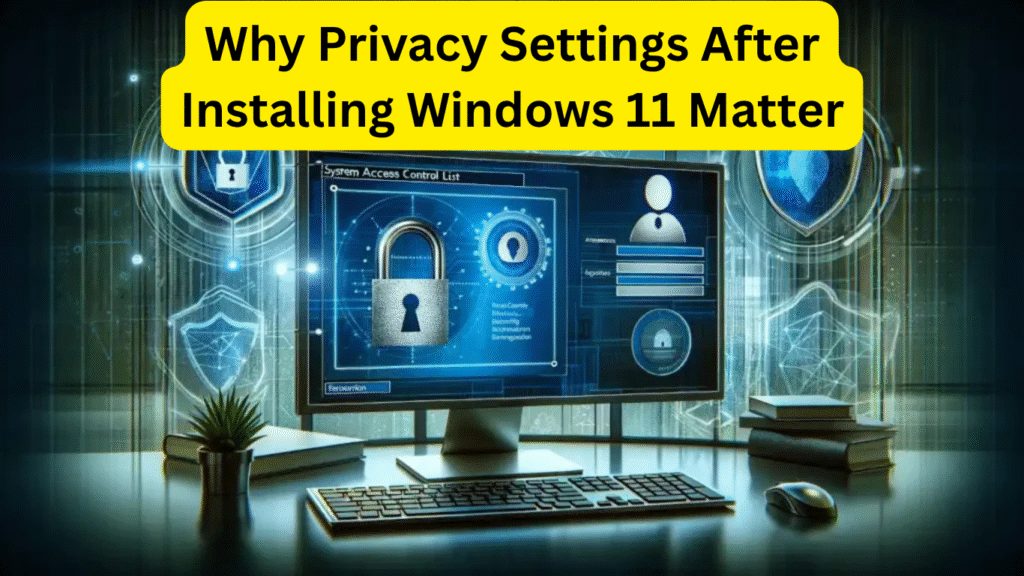Windows 11 brings a sleek interface and powerful features, but it also comes packed with data-sharing defaults that may compromise your privacy. If you’ve just installed Microsoft’s latest operating system, configuring the right privacy settings after installing Windows 11 should be a top priority.
In this guide, we’ll walk you through 7 critical privacy settings to tweak after installing Windows 11, ensuring your personal data stays secure and your system runs with minimal unwanted tracking.
1. Disable Ad Tracking
Windows 11 assigns a unique advertising ID to your device, which is used to serve personalized ads across apps. To protect your privacy:
- Go to Settings > Privacy & Security > General
- Turn off “Let apps show me personalized ads by using my advertising ID”
Disabling this setting ensures that Microsoft and third-party apps don’t track your behavior for marketing purposes.
2. Manage Location Access
While location services can be helpful for apps like Maps and Weather, constant access to your location can be a privacy risk. To adjust this:
- Go to Settings > Privacy & Security > Location
- Turn off location services entirely, or allow access only for specific apps
You can also clear your location history from this section for added privacy.
3. Disable Diagnostic Data Collection
By default, Windows 11 collects diagnostic data to “improve user experience.” However, this data can include app usage, system logs, and more. Here’s how to limit this:
- Go to Settings > Privacy & Security > Diagnostics & Feedback
- Choose “Required Diagnostic Data” instead of full
- Toggle off “Send optional diagnostic data”, “Improve inking & typing”, and “Tailored experiences”
This is a key privacy setting to change after installing Windows 11, especially if you value control over what’s shared with Microsoft.
4. Turn Off Activity History Syncing
Windows 11 syncs your activity history across devices, which can include browsing history, app usage, and documents. To stop this:
- Go to Settings > Privacy & Security > Activity History
- Uncheck “Store my activity history on this device”
- Also, turn off “Send my activity history to Microsoft”
Removing activity syncing gives you more control over what’s stored and shared across devices.
5. Review App Permissions
Another crucial privacy setting after installing Windows 11 is controlling app permissions. Some apps request access to your microphone, camera, contacts, and more—sometimes unnecessarily.
To check and modify permissions:
- Go to Settings > Privacy & Security
- Under App Permissions, review each category (e.g., Microphone, Camera, Contacts)
- Disable access for apps that don’t need it
This helps minimize data leakage and protects against unauthorized access.
6. Disable Background Apps
Background apps can continue to collect data or consume system resources even when you’re not actively using them. To disable this:
- Go to Settings > Apps > Installed Apps
- Click the three-dot menu next to an app > Advanced options
- Under Background App Permissions, choose “Never”
Alternatively, disable them globally by going to Settings > Privacy & Security > Background Apps.
7. Control Cortana & Voice Data
Cortana is less prominent in Windows 11, but voice data collection might still occur depending on your settings.
- Go to Settings > Privacy & Security > Speech
- Toggle off Online speech recognition
This prevents Microsoft from storing your voice inputs for future use.
Why Privacy Settings After Installing Windows 11 Matter

Failing to tweak your privacy settings leaves you vulnerable to unnecessary data collection, targeted ads, and potential security risks. By taking control of these settings, you’re safeguarding your digital identity, improving system performance, and minimizing intrusive behaviors by both Microsoft and third-party apps.
FAQs About Privacy Settings in Windows 11
Q1: Is Windows 11 more privacy-invading than Windows 10?
Windows 11 continues many of Windows 10’s telemetry and data collection practices, but gives users more control via privacy settings. Adjusting them is essential for better privacy.
Q2: Can I trust Microsoft with my data if I leave the settings unchanged?
While Microsoft states it uses data for feature improvements, leaving everything enabled means more data is collected than necessary. It’s always safer to customize privacy settings.
Q3: Does disabling these settings affect performance or features?
Not significantly. In fact, turning off unnecessary background processes and telemetry can improve performance and battery life on laptops.
Q4: What tools can help manage privacy better on Windows 11?
Apps like O&O ShutUp10++ or W10Privacy provide more advanced control over privacy settings, but use them cautiously as they alter system policies.
Final Thoughts
Adjusting privacy settings after installing Windows 11 is not just optional—it’s essential. These 7 tweaks help you take control of your personal data and enjoy a more secure computing experience. Don’t let default settings compromise your digital life. Set your system right from day one.
For more Windows 11 tips, tricks, and privacy guides, be sure to bookmark SolvingDad.com!
